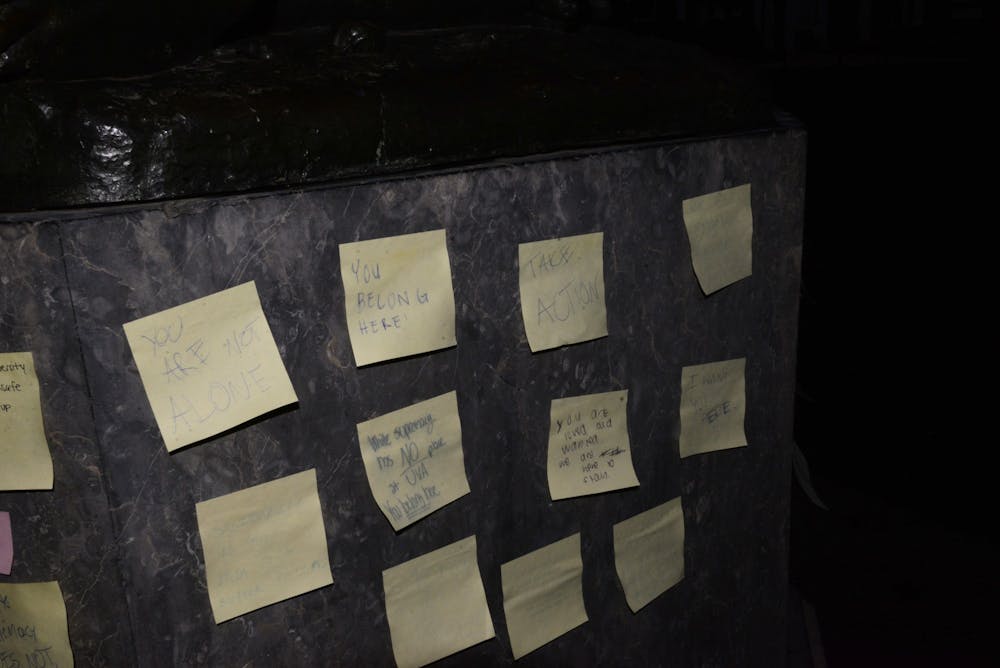The Young Democratic Socialists of America at U.Va. organized a protest at 12 p.m. Monday on the South Lawn in response to the Sept. 7 hate crime at the same location, when an unknown suspect hung a noose around the neck of the Homer Statue. Students and community members came together to process the violent act and demand a stronger University response to acts of white supremacy.
YDSA leaders gathered shortly before noon to place a bouquet at the base of the Homer Statue. Participants joined around the South Lawn carrying signs decorated with phrases such as “All Hoos Belong” and “No Hate on Grounds.”
The hate crime occurred at 11:15 p.m Wednesday evening, when a male wearing dark clothing climbed the Homer Statue, left the noose around its neck and departed on foot. Security noticed the noose at 4:20 a.m.
Ella Tynch, chair of YDSA communications and fourth-year Education student, welcomed protesters and clarified that volunteers wearing pink bandanas were present to ensure the peacefulness of the event. She then reminded listeners of the power of the collective.
“There are more people here than the person who hung that noose,” Tynch said. “We do have power. We just have to organize and keep educating ourselves and working for a better future.”
Tynch then introduced several student speakers. Later, Jalane Schmidt, associate professor and director of the Memory Project, discussed the hate crime in the context of the University’s history of enslavement, highlighting that enslaved laborers built the very Lawn that houses the Homer Statue and that Jefferson first created the University to retain white talent in the South.
“It was a struggle to integrate U.Va. in the twentieth century,” Schmidt said. “And even today in the twenty-first century, [people of color] don’t always feel safe here.”
She then referenced the events of Aug. 11 and 12, 2017, when white supremacists marched down the Lawn to protest the removal of the Robert E. Lee statue. The next day, protests turned violent, with white supremacist James Fields driving a car through a crowd of counter-protestros — injuring 19 and killing Charlottesville resident Heather Heyer.
“Our best response to the violence and terror of the ‘Unite the Right’ rally and to this recent act of intimidation is to join together as a community,” Schmidt said.
A representative for the Black Student Alliance then read the Sept. 8 statement posted by the group in response to the hate crime.
“The noose is a symbol of hatred and brutality toward the Black community,” the post reads. “It is critical that Black students feel safe at the University of Virginia, but also feel empowered to claim this university as our university.”
Tynch invited protesters to chalk messages of solidarity on the pavement surrounding the base of the statue or to leave post-it notes on the statue itself.
Tim Wilson, treasurer of YDSA and third-year College student, left a Post-It behind the words “What are you doing to fight white supremacy?” Wilson explained his frustration with the University’s treatment of the hate crime and of the long history of racism on Grounds.
Though University President Ryan addressed the hate crime in a community-wide email Thursday, Wilson remains doubtful.
“We've seen that the University just leaves a simple email, or there's really nothing in terms of action toward heinous actions like this,” Wilson said. “We just wanted to organize this event as a symbol of solidarity that we are not okay with this.”
Other individuals said they hope the University does not respond with increased police activity.
“You can't increase surveillance and policing of students to address the problem of white supremacy when these systems are the result of white supremacy in the first place,” Tynch said.
Instead, Schmidt said that community solidarity represents the most effective path forward.
“The person who left this noose was afraid of being seen because they knew that they were violating basic community standards,” Schmidt said. “They knew that decent people would repudiate them — as we are doing here right now, together, in the light of day. Because there is safety in numbers, and we will overcome fear with solidarity.”







